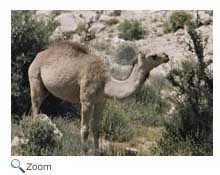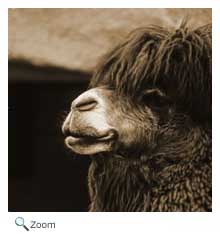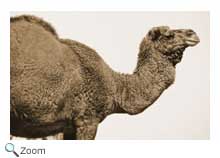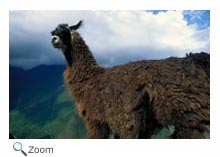Camelidae - camels, llamas, alpacas, vicugnas
 The six species in this family are found in two groups. Camels are found in Asia and Africa. Llamas, alpacas, and vicugnas are found in South America. The species in this family are large and most of them have been domesticated. They are herbivores and have three-chambered stomachs. Their top lip is split into two and they can move each part separately! They have long necks and a small head and long legs with padded feet with two large toes. They live in small groups made up of females and their young and one adult male. Although there are no living species of camelidae family in North America
today, the fossil record shows that the family started and evolved there. Scientists have found preserved remains in the La Brea Tar Pits near Los Angeles. The members of the camelidae family that were in North America probably resembled llamas. Members of this family migrated to South America and Asia over land bridges. By the end of the last glacial age, they had become extinct in North America. The six species in this family are found in two groups. Camels are found in Asia and Africa. Llamas, alpacas, and vicugnas are found in South America. The species in this family are large and most of them have been domesticated. They are herbivores and have three-chambered stomachs. Their top lip is split into two and they can move each part separately! They have long necks and a small head and long legs with padded feet with two large toes. They live in small groups made up of females and their young and one adult male. Although there are no living species of camelidae family in North America
today, the fossil record shows that the family started and evolved there. Scientists have found preserved remains in the La Brea Tar Pits near Los Angeles. The members of the camelidae family that were in North America probably resembled llamas. Members of this family migrated to South America and Asia over land bridges. By the end of the last glacial age, they had become extinct in North America.
 The bactrian camel is found in the
Gobi desert in Mongolia and China. The Gobi desert is a cold desert and the bactrian camel has many adaptations that help is survive in a cold desert habitat. It has two humps on its back. The hump is not filled with water; it is filled with fat. The camel uses this stored fat when water and food are scarce. While the bactrian camel doesn't store water in its humps, it does have special sack in its stomach that can hold over a gallon of water, and it can go a few days without drinking. In the winter, it has a thick, shaggy coat that helps keep it warm. Its bushy eyebrows; long double rows of eyelashes; and nostrils and lips that close tightly help keep sand out of its eyes, nose, and mouth. The bactrian camel stands as tall as seven feet from its shoulder to its feet and can weigh up to 2,000 pounds. The bactrian camel is an herbivore and eats
grass, leaves, thorns, and bark. It prefers salty plants. It has tough lips that let it eat very hard vegetation. Most bactrian camels are now domesticated and there are only a few hundred in the wild. The bactrian camel is found in the
Gobi desert in Mongolia and China. The Gobi desert is a cold desert and the bactrian camel has many adaptations that help is survive in a cold desert habitat. It has two humps on its back. The hump is not filled with water; it is filled with fat. The camel uses this stored fat when water and food are scarce. While the bactrian camel doesn't store water in its humps, it does have special sack in its stomach that can hold over a gallon of water, and it can go a few days without drinking. In the winter, it has a thick, shaggy coat that helps keep it warm. Its bushy eyebrows; long double rows of eyelashes; and nostrils and lips that close tightly help keep sand out of its eyes, nose, and mouth. The bactrian camel stands as tall as seven feet from its shoulder to its feet and can weigh up to 2,000 pounds. The bactrian camel is an herbivore and eats
grass, leaves, thorns, and bark. It prefers salty plants. It has tough lips that let it eat very hard vegetation. Most bactrian camels are now domesticated and there are only a few hundred in the wild.
 The
dromedarian camel is found in the deserts in Africa and the Middle East. It has one hump that stores fat, not water. It stands 6-7 feet from its shoulder to its feet. It has long legs and padded feet with two toes. It has a long, curved neck and a small head with a long snout with nostrils that can close. Its upper lip is split into two sections, and it can pull its lips in tightly to keep out sand. It is light brown in color and has a shorter coat than the bactrian camel. It eats a wide variety of plants and can eat tough and hard plant parts that other animals can't chew or digest. It prefers salty plants. The
dromedarian camel is found in the deserts in Africa and the Middle East. It has one hump that stores fat, not water. It stands 6-7 feet from its shoulder to its feet. It has long legs and padded feet with two toes. It has a long, curved neck and a small head with a long snout with nostrils that can close. Its upper lip is split into two sections, and it can pull its lips in tightly to keep out sand. It is light brown in color and has a shorter coat than the bactrian camel. It eats a wide variety of plants and can eat tough and hard plant parts that other animals can't chew or digest. It prefers salty plants.
 The llama, the
guanaco, and the alpaca. They are all native to the Andes Mountains in South America and they are all herbivores. The only wild species is the guanaco. The llama and the alpaca are domesticated. The guanaco is found in the grasslands of the Andes Mountains. It has a small head, long legs, and a long neck. It is about 3.5 feet tall from shoulder to feet. It has a shaggy, reddish-brown coat and is white on its undersides. Like the camels, it has a split upper lip. It eats grasses and shrubs. The guanaco lives in groups of females and their young and one adult male. It can run at speeds of up to 35 miles per hour. The guanaco is a protected species in Chile and Peru. The llama and the alpaca are descended from the guanaco. The llama was domesticated from the guanaco 4,000-5,000 years ago. Llama were used as pack animals. The llama is
5.5-6 feet tall from head to toe.
It has two toes on its padded feet and can easily grip the rocky surfaces in its mountain habitat. The llama has long, shaggy fur. Its fur can vary in color from reddish-brown, to white, black, brown, or a combination of colors. Llama fur is used to make clothes. The alpaca was also domesticated from the guanaco. The alpaca is slightly smaller than the llama. It is about 5 feet tall from its head to its toes. It looks like the llama. Unlike the llama, the alpaca is not used as a pack animal, but its soft, shaggy fur is used to make clothing. The llama, the
guanaco, and the alpaca. They are all native to the Andes Mountains in South America and they are all herbivores. The only wild species is the guanaco. The llama and the alpaca are domesticated. The guanaco is found in the grasslands of the Andes Mountains. It has a small head, long legs, and a long neck. It is about 3.5 feet tall from shoulder to feet. It has a shaggy, reddish-brown coat and is white on its undersides. Like the camels, it has a split upper lip. It eats grasses and shrubs. The guanaco lives in groups of females and their young and one adult male. It can run at speeds of up to 35 miles per hour. The guanaco is a protected species in Chile and Peru. The llama and the alpaca are descended from the guanaco. The llama was domesticated from the guanaco 4,000-5,000 years ago. Llama were used as pack animals. The llama is
5.5-6 feet tall from head to toe.
It has two toes on its padded feet and can easily grip the rocky surfaces in its mountain habitat. The llama has long, shaggy fur. Its fur can vary in color from reddish-brown, to white, black, brown, or a combination of colors. Llama fur is used to make clothes. The alpaca was also domesticated from the guanaco. The alpaca is slightly smaller than the llama. It is about 5 feet tall from its head to its toes. It looks like the llama. Unlike the llama, the alpaca is not used as a pack animal, but its soft, shaggy fur is used to make clothing.
The vicugna is found in the plains and grasslands of the Andes Mountains. It is the smallest member of the camelidae family. It is three feet tall from shoulder to feet. It has a slender body; a long neck; thin legs; and long, silky fur. It is a reddish-brown on its uppersides and white on its undersides. It has a mane of hair on its chest. The
the vicugna is also known as the vicuña.
World Status Key
 Least Concern Least Concern  Near Threatened Near Threatened  Vulnerable Vulnerable  Endangered Endangered  Critically Endangered Critically Endangered
 Extinct in the Wild Extinct in the Wild  Extinct Extinct
Status and range is taken from ICUN Redlist. If no status is listed, there is not enough data to establish status.
US Status Key
 Threatened in US Threatened in US  Threatened in NH Threatened in NH  Endangered in US Endangered in US  Endangered in NH Endangered in NH
 Breeds in NH Breeds in NH  Introduced Introduced
Status taken from US Fish and Wildlife and NH Fish and Game
New Hampshire Species |
|
North/Central American Species |
None
|
|
None |
Additional Information
Key:  Profile Profile  Photos Photos  Video Video  Audio Audio
Camel  
Did you know that camels were domesticated more than 3,000 years ago?
Source: San Diego Zoo Intended Audience: General Reading Level: Elementary/Middle School
Alpaca - Lama pacos   
Alpacas spit when they are angry.
Source: Los Angeles Zoo Intended Audience: General Reading Level: Elementary/Middle School
Alpaca - Lama pacos   
The native range of the alpaca is the central and southern Andes from Peru to Argentina.
Source: Animal Diversity Web Intended Audience: General Reading Level: Middle/High School
Bactrian Camel - Camelus ferus     
All domestic camels are descended from the Bactrian camel.
Source: Arkive Intended Audience: General Reading Level: Middle School
Bactrian Camel - Camelus ferus      
All domestic camels are descended from the Bactrian camel.
Source: BBC Intended Audience: General Reading Level: Middle School
Bactrian Camel - Camelus ferus    
Wild Bactrian camels live in northwestern China and Mongolia. Wild Bactrian camels are critically endangered.
Source: National Zoo Intended Audience: General Reading Level: Elementary/Middle School
Bactrian Camel - Camelus ferus     
Bactrian camels can drink 30 gallons of water in just 13 minutes. Yikes!
Source: Los Angeles Zoo Intended Audience: General Reading Level: Elementary/Middle School
Bactrian Camel - Camelus ferus    
Bactrian camels have two humps.
Source: Animal Diversity Web Intended Audience: General Reading Level: Middle/High School
Bactrian Camel - Camelus ferus    
Bactrian camels have pads on their knees that protect their skin when they kneel on the rocky ground.
Source: Minnesota Zoo Intended Audience: General Reading Level: Middle School
Bactrian Camel - Camelus ferus    
Camels are called the 'ship of the desert'. They have been domesticated as beasts of burden longer than any other mammal.
Source: Utah's Hogle Zoo Intended Audience: Students Reading Level: Middle School
Bactrian Camel - Camelus ferus    
Bactrian camels can reach seven feet in height and weigh up to 1,500 pounds.
Source: Lincoln Park Zoo Intended Audience: General Reading Level: Elementary/Middle School
Bactrian Camel - Camelus ferus    
Wild Bactrian camels are adapted to handle the extreme temperature changes found in the wild.
Source: Chicago Zoological Society Intended Audience: Students Reading Level: Elementary/Middle School
Bactrian Camel - Camelus ferus     
Long eyelashes and elongated nostrils protect Bactrian camels from blowing dust and sand.
Source: St. Louis Zoo Intended Audience: General Reading Level: Elementary/Middle School
Bactrian Camel - Camelus ferus   
The Bactrian camel's two humps contain fat, not water.
Source: Enchanted Learning Intended Audience: Students Reading Level: Elementary School
Dromedary - Camelus dromedarius     
The dromedary's hump stores up to 80 pounds of fat that a camel can break down into water and energy when food and water is not available.
Source: National Geographic Intended Audience: General Reading Level: Elementary/Middle School
Dromedary - Camelus dromedarius    
The Arabian camel eats plants. They have a leathery mouth that lets them eat thorns and dry vegetation. Yum!
Source: The Living Desert Intended Audience: Students Reading Level: Elementary/Middle School
Dromedary- Camelus dromedarius    
The dromedary eat practically anything that grows in the desert, including salty plants rejected by other grazers.
Source: Oakland Zoo Intended Audience: Students Reading Level: Elementary/Middle School
Dromedary- Camelus dromedarius    
The dromedary has one hump.
Source: Animal Diversity Web Intended Audience: General Reading Level: Middle/High School
Dromedary- Camelus dromedarius   
The dromedary has padded feet that help it walk on the hot sand!
Source: Enchanted Learning Intended Audience: Students Reading Level: Elementary School
Guanaco - Lama guanicoe    
This South American animal is related to camels and, like camels, they were were domesticated.
Source: San Diego Zoo Intended Audience: General Reading Level: Elementary/Middle School
Guanaco - Lama guanicoe     
The guanaco is the largest wild member of the camelid family in South America, and is believed to be the ancestor of the domestic llama.
Source: Arkive Intended Audience: General Reading Level: Middle School
Guanaco - Lama guanicoe    
The guanaco is found from southern Peru down the Andean zone of Chile and Argentina to Tierra del Fuego and Navarino Island.
Source: Animal Diversity Web Intended Audience: General Reading Level: Middle/High School
Guanaco - Lama guanicoe    
Guanacos are usually found in small herds or loosely structured family groups.
Source: Animal Planet Intended Audience: General Reading Level: Middle School
Llama - Lama glama   
The scientific name for llama is Llama glama!
That's just fun to say!
Source: Brandywine Zoo Intended Audience: General Reading Level: Middle School
Llama- Lama glama   
The llama has a four-chambered stomach.
Source: Honolulu Zoo Intended Audience: General Reading Level: Middle School
Llama- Lama glama   
The llamas native range is the Andes mountains, but they are no longer not found in the wild.
Source: Animal Diversity Web Intended Audience: General Reading Level: Middle/High School
Vicuña - Vicugna vicugna     
The vicuña is the smallest member of the camelid family.
Source: Arkive Intended Audience: General Reading Level: Middle School
Vicuña - Vicugna vicugna    
The vicuña lies in the Andes of southern Peru, western Bolivia, northwestern Argentina, and northern Chile.
Source: Animal Diversity Web Intended Audience: General Reading Level: Middle/High School
Vicuña - Vicugna vicugna    
The vicuña's coat is very thick and traps warm air.
Source: Edinburgh Zoo Intended Audience: Students Reading Level: Elementary/Middle School
|




